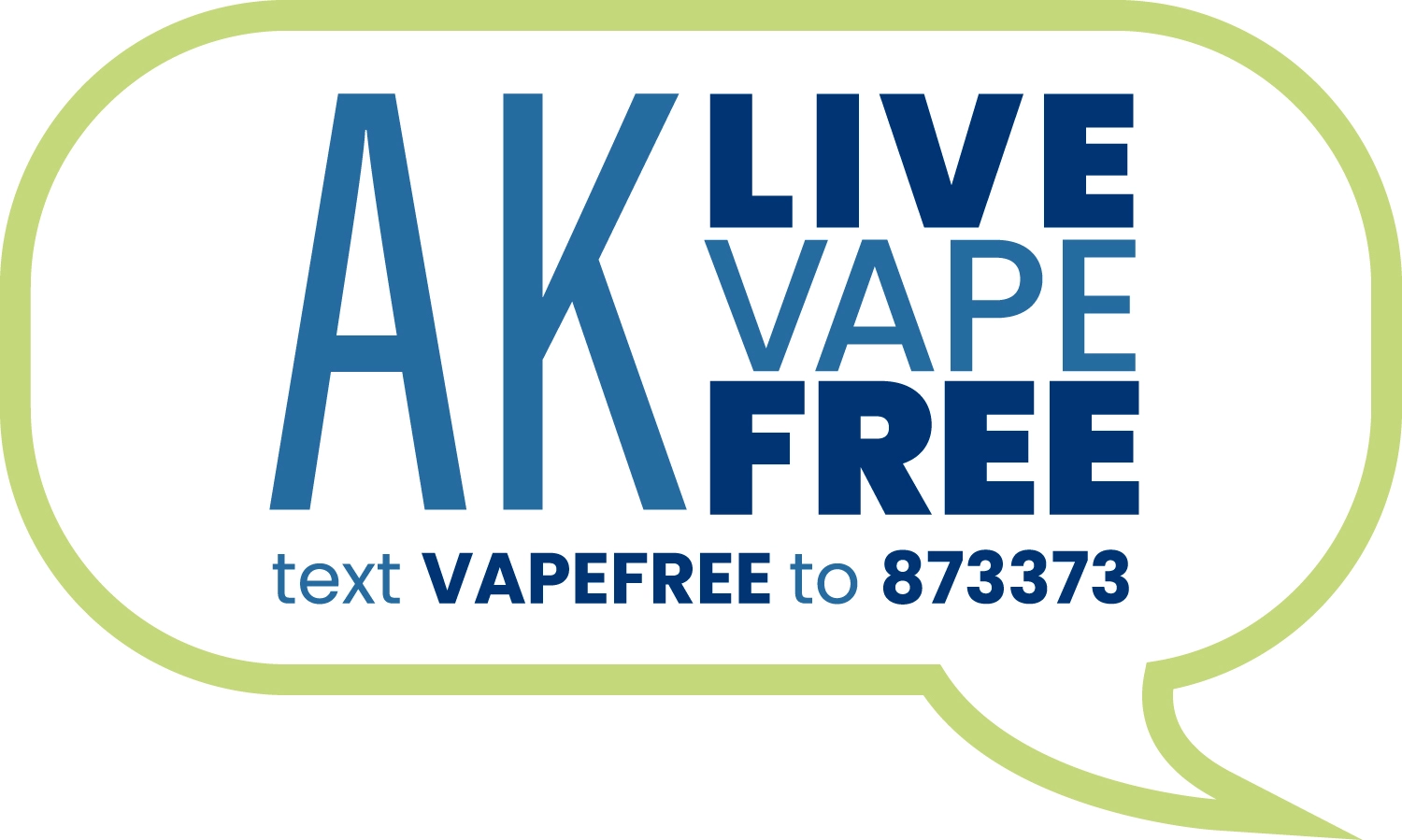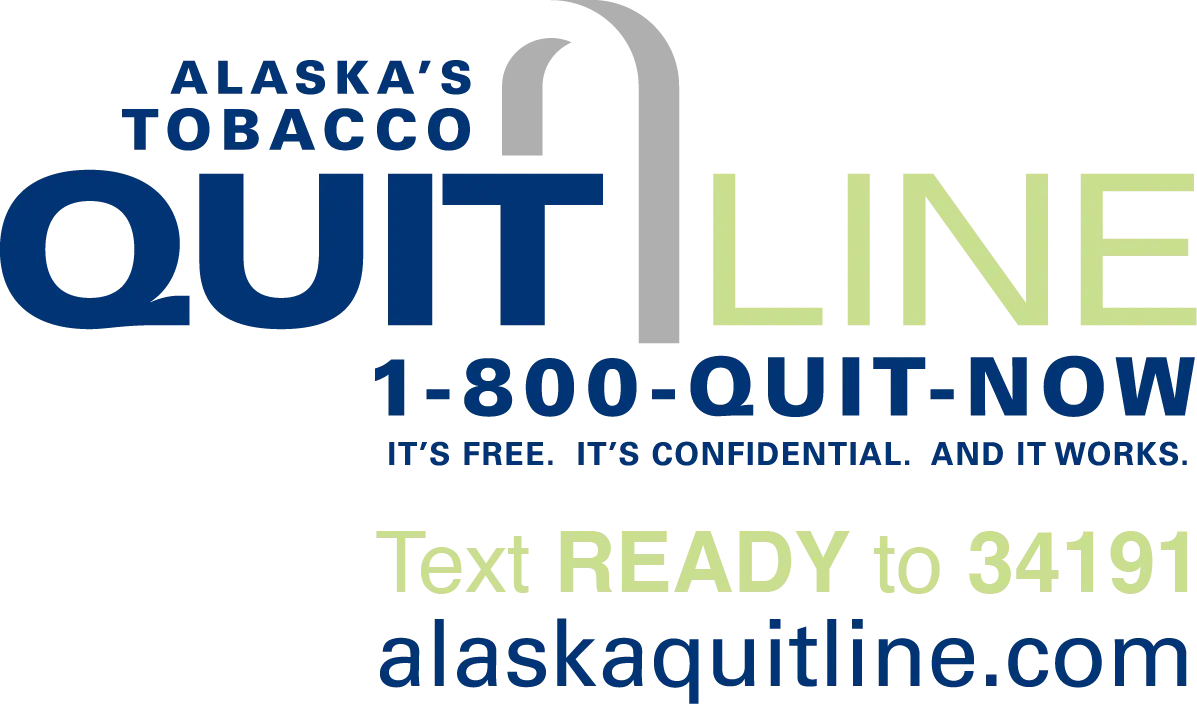Alaska Resources Hub
Resource hub for Alaska’s Tobacco Prevention and Control granteesLearn about Commercial Tobacco and Vaping
Resources for Youth
Find educational tools for youth to understand risks of vaping and commercial tobacco use along with intervention and cessation programs specifically for teens.
- Not for Me Online Free, self-guided, mobile-friendly teen cessation program.
- Not On Tobacco® (N-O-T) Facilitator-led teen smoking and vaping cessation program.
- Live Vape Free Alaska Confidential texting cessation program for teens. Join for free by texting VAPEFREE to 87337.
Resources for Parents
Many parents want to talk to their kids about smoking but need help. Learn about the health effects of vaping and smoking and how to start a conversation with your child.
Resources for Schools
Youth tobacco use and vaping is an issue in schools across Alaska. The Lung Association offers programs to help schools respond effectively to youth tobacco and vaping on campus and to help students quit all commercial tobacco use and vaping for good. We also provide training and technical assistance (TA) to help schools and districts review and update vaping and tobacco policies.
- Vape Free Schools Initiative Be a leader in supporting students affected by tobacco products, including e-cigarettes, offering clear guidance, education and cessation.
- INDEPTH: An Alternative to Teen Nicotine Suspension or Citation Program offered as an option to students who face suspension for violation of school tobacco use policies. Facilitators can complete certification at no cost and even download all the materials needed to run INDEPTH at no charge.
- N-O-T (Not on Tobacco) Facilitator Training Become a cessation facilitator for youth in your school or community. For more information or to ask about scholarships reach out to [email protected].
Schools and districts want all staff to be tobacco and nicotine free and may want to share resources.
- How to Help People Quit Free, one-hour online course to enhance understanding of tobacco cessation, behavior change, and the interventions and treatment needed to help people quit for good.
- Alaska Tobacco Quit Line Free to Alaskans and offers access to free telephone, web and text-based support to quit tobacco. You can call as often as you like and are eligible to receive four pro-active support calls from a quit coach. Alaska’s Tobacco Quit Line offers free nicotine replacement therapy (NRT) to all Alaskans who enroll in the program. NRT is available even if you are uninsured or without coverage from your health plan. To enroll, call Alaska’s Tobacco Quit Line at 1-800-QUIT-NOW (1-800-784-8669), text READY to 34191, or visit the link above.
Many schools and districts find that their tobacco policies need review and could potentially benefit from updating. The Lung Association can provide detailed policy and student handbook analysis and recommend updates to make any policy more complete and able to withstand future product changes and innovations. Listed below are some of the resources available to support schools and districts in achieving and maintaining tobacco free campuses.
- Policy Change Resource Toolkit Customized resources to help schools and districts update their vaping and tobacco policies. Includes a policy change guide outlining a 6-step process to update a school tobacco policy along with a set of resources to help with each step in the process.
- American Lung Association’s Campaign Guide More on how to update or create a comprehensive tobacco and nicotine free campus policy.
Healthcare Provider Resources
- ACT to Address Youth Cessation Free, one-hour on-demand, online course that provides an overview for healthcare professionals, school personnel and community members working with youth on conducting brief interventions for youth who use tobacco.
- Ask, Advise, Refer to Quit Don’t Switch Utilizes updated tools and strategies for conducting an effective brief tobacco intervention with patients identified as tobacco users, including e-cigarettes.
- Lung Cancer Screening Resources Lung cancer can be a challenging subject for your patients. These resources can help you and your patients better understand lung cancer screening.
Tobacco & Lung Health Resources
The American Lung Association created mini-resource toolkits with different topics on tobacco and lung health. The topics range from lung cancer, pregnancy and tobacco, COPD awareness, to many more. The aim is to bring forth new topics and provide resources that grantees might find helpful.
Smokefree Environments
The American Lung Association in Alaska advocates for and assists with implementation of smokefree housing policies throughout the state. We believe that everyone has the right to breathe clean air, especially at home.
The CDC has estimated that 99% of adult cigarette smokers first start smoking before age 26 years and many smokers transition to regular, daily use during young adulthood colleges and universities represent an important venue for protecting students, faculty, staff members, and guests from secondhand smoke exposure through tobacco control policies.
Studies have also found that levels of secondhand smoke exposure outdoors can reach levels recognized as hazardous, depending on direction and amount of wind, number and proximity of smokers, and enclosures such as walls or roofs. Smokefree policies help individuals who are trying to quit, by eliminating the sight and smell of smoke. As with all smokefree policies, these measures send a message to children and youth that tobacco use is not an acceptable behavior or a norm in the community.
Coalition Resources
Coalitions contribute significantly to building momentum for change in communities working on tobacco prevention. Coalitions can look different in many communities but usually are composed of diverse and inclusive members who bring together people and organizations with wide-ranging skills and knowledge.
- Advocacy Basics Free interactive online learning program to understand more about lung health advocacy and how to get involved.
- Best Practices User Guides-Partnerships in Tobacco Prevention and Control Guide to help tobacco control staff and partners implement evidence-based best practices by translating research into practical guidance.
Commercial Tobacco Use in Communities
- Addressing Tobacco Use in the Black Community Toolkit
- Addressing Tobacco Use in Hispanic or Latino Communities Toolkit: English | Spanish
- Addressing Commercial Tobacco Use in Indigenous Communities Toolkit
- Protect Lung Health for Military Veterans and Contractors
Page last updated: December 10, 2025




.jpg?format=webp)


